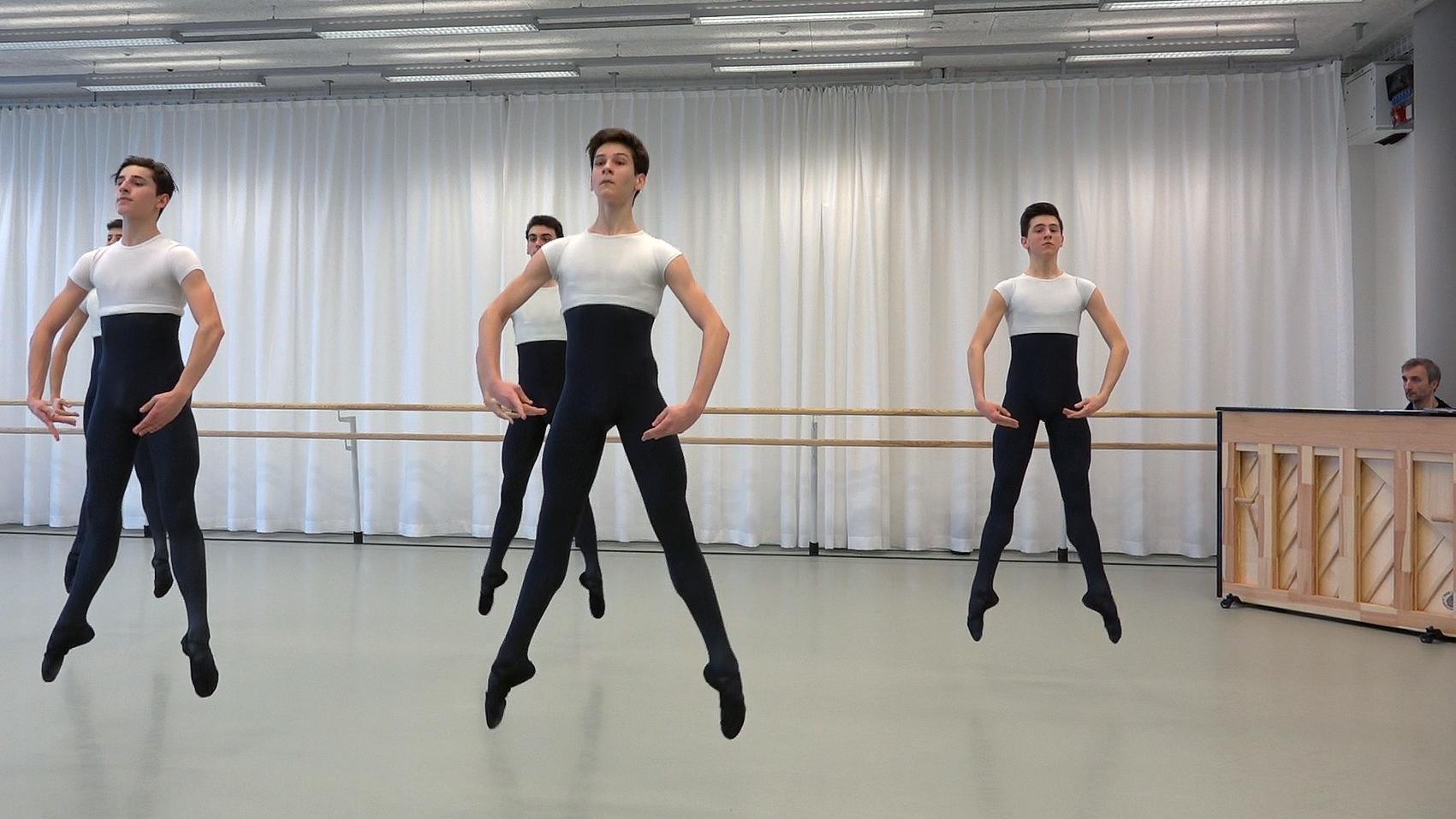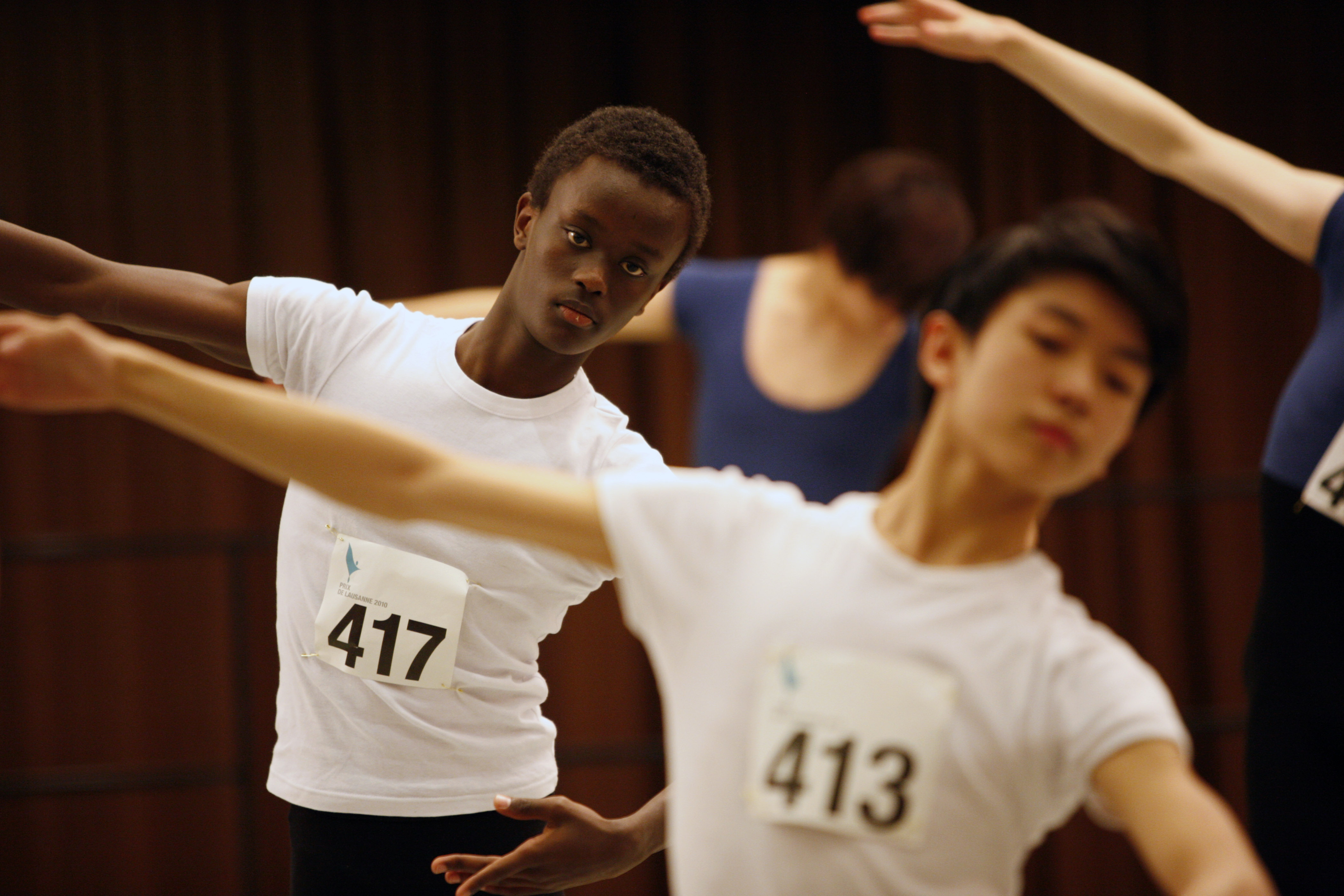Making the grand jeté from ballet backwater to boom

The Prix de Lausanne international ballet competition can make careers. But it takes place in a country without a strong dance tradition. The Zurich Dance Academy is one of two Swiss state-funded schools trying to turn that around.
Lou Spichtig and Laura Fernandez-Gromova are gearing up for what could be their big break. The Swiss girls, both aged 17, are among the 70 candidates – selected from 300 – who will be performing in front of judges during the week-long international PrixExternal link that starts on February 1. The contest is regarded as a springboard for young dancers, with scholarships on offer for top ballet schools and companies.
We are in a large dance studio at the Zurich Dance AcademyExternal link. Laura is trying out her costume for the classical variation for the first time. It’s a beautifully embroidered tutu, with black and gold, but the corsetry is not yet right. Her teacher, Tina Goldin, says adjustments should be made. “It’s important that it sits right, you don’t want to be distracted by it,” she says.
Goldin is providing extra coaching ahead of the Prix. “There was a list of eight classical variations to choose from and of course we try and choose one that best matches the girl’s character,” she explains to swissinfo.ch. The girls also have to perform a contemporary variation.

More
The long road to Lausanne
Budding talents
Oliver Matz, director of dance studies, says the school’s motivation in preparing young people for competition was first and foremost to encourage budding talents. Teachers also help participants through what can be a nerve-wracking experience.
“It’s important that the young people can perform to the best of their abilities on stage,” he explains.
The Prix de Lausanne is an international competition for young dancers of all nationalities aged 15 to 18 who are not yet professionals. Candidates have to get through video-based preliminaries and pre-selections. Only 20 will reach the final. Prizes are scholarships to schools or apprenticeships to companies. There is also a contemporary prize and a best Swiss candidate prize (Swiss or pupil of Swiss dance school). Former famous winners include: Darcey Bussell, retired Prima Ballerina of the Royal Ballet, and Carlos Acosta, principal guest artist with the Royal Ballet. The Zurich Dance Academy is a Prix partner school. The Swiss partner ballet companies are Béjart Ballet Lausanne, Zurich Ballet, Ballet du Grand Théâtre Geneva.
Both girls have some pedigree: Lou is the winner of the 2013 Youth America Grand Prix External linkin New York, Laura reached the final there in 2014.
Lou first saw the Prix as a young girl and says taking part was “a childhood dream that’s finally coming true.” Both she and Laura want to convey their passion for dance in their variations. “I really want to show that I like ballet and I want to do this for my whole life,” Laura notes.
Building a reputation
The Zurich Dance Academy has only existed in its present form for just over ten years. Matz and his partner Steffi Scherzer, both former principal ballet soloists at the German State Opera in Berlin, took over what was the Swiss ballet vocational school in 2005, basing it on what they had experienced in their training.
The school is now part of the Department of Performing Arts and Film at the Zurich University of the Arts (ZHdK)External link and since last year has benefited from more space and larger studios at the ZHdK’s new Toni-Areal location. The other Swiss professional classical school is in BaselExternal link.
“We have managed in a relatively short time to build up a school which has made an impact internationally and to say, ‘look here in Switzerland, which is not a traditional classical dance country, there is a school in which Swiss and international children and young people can study to train as professional dancers’,” Matz explains.
Professionalisation
Around 60% of pupils are Swiss, so there is an interest in dance, Matz says. “But when it comes to professional dance training, Switzerland is still a bit in its infancy. But there is a big consensus that training should be professionalised.”
As well as classical training in Zurich and Basel, there is now professional contemporary training in GenevaExternal link. “A new generation will come from this, which will make an impact on the international market, I am sure of that,” Matz says.
Lou and Laura, who are final year students, will leave with a Federal Certificate of Proficiency. Around 90% of graduates join international dance companies. The success rate is equivalent to that of more established ballet schools, such as the English National Ballet School in London.
Classical and contemporary
Until then there is up to six hours of training a day to do. In Scherzer’s class, 15-year-old girls were being put through their paces at the barre. Although graceful, they did not yet have the polish of Lou and Laura, highlighting the difference two years can make.
Pupils start aged 11 with foundation training, moving to advanced studies at age 15. In Matz’s class, the boys – they make up 44% of pupils – were concentrating as they jumped. “Left foot,” points out Matz. “Good.”

More
A day at dance school
Classical is just one part of the school’s offer, as it’s important to offer high quality contemporary training as well, Matz says.
“No company only does Swan Lake, Gisele and the Nutcracker these days. They also work with international dance scene choreographers who create their pieces on the basis of classical dance,” he says. “Our young people are trained for this, so that they can speak both dance languages.”
Success story
2012 Prix de Lausanne winner and former academy pupil Nikolaus TudorinExternal link is one of the school’s success stories. Now working for the Leipzig BalletExternal link in Germany, the Australian told swissinfo.ch that studying at the school was one of the best decisions he had made so far.
“It is so important for young dancers to decide what school will be the best for them to grow and achieve their goals and dreams. But it is also a very hard one, especially if you don’t know much about the school that you’re going to, which was the case for me when leaving Australia at 16 to go Switzerland to train,” he said.
Liliana Heldner from Danse SuisseExternal link, the association of Swiss dance professionals, said that the high percentage of students going directly into jobs after graduating was “remarkable”.
Switzerland’s decision to introduce the Federal Certificate of Proficiency in 2009 led to dance being formally recognised as a profession – very late compared with other countries. The Zurich Dance Academy was then the first to introduce a professional qualification for classical dance. This has been a factor in its success, Heldner said, and has encouraged many Swiss parents to support their offspring’s dance dreams.
“A diploma is also useful at the end of a career on stage. You might want to go into teaching, management, be a physiotherapist specialised in dance or something completely different. You still have 25 years ahead of you and a diploma opens the door to other training.”
Foundation courses start age 11-12. There is a boarding school for pupils from further afield in Switzerland and abroad. Students also receive guidance in nutrition and there is specialised medical care. Advanced studies start at age 15-16 with students graduating age 19. The training is equal to an apprenticeship and leads to a Federal Certificate of Proficiency. The Zurich University of the Arts also offers a Bachelor of Arts in Contemporary Dance. An equivalent can be undertaken at the University of Applied Sciences and Arts Western Switzerland.

In compliance with the JTI standards
More: SWI swissinfo.ch certified by the Journalism Trust Initiative












You can find an overview of ongoing debates with our journalists here . Please join us!
If you want to start a conversation about a topic raised in this article or want to report factual errors, email us at english@swissinfo.ch.